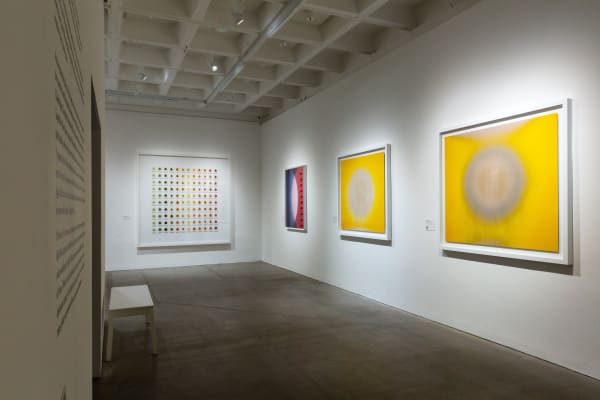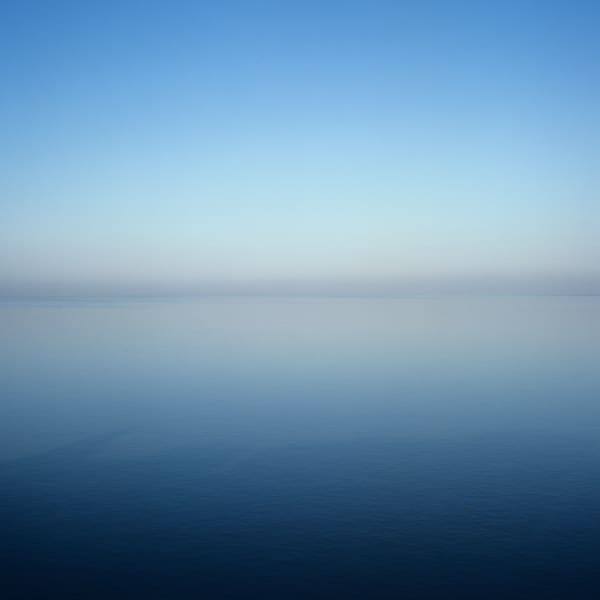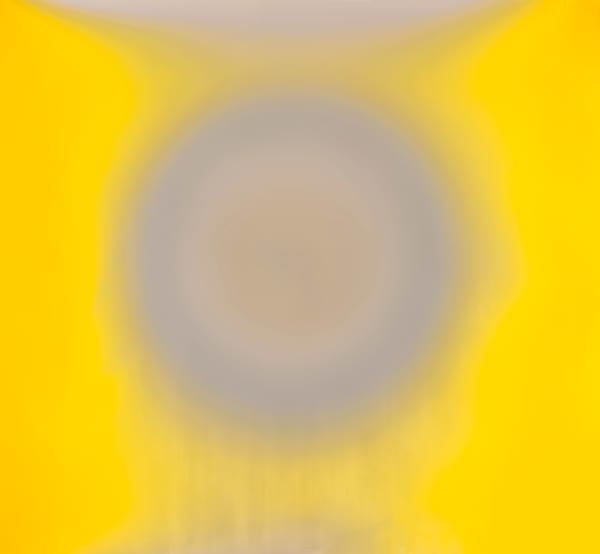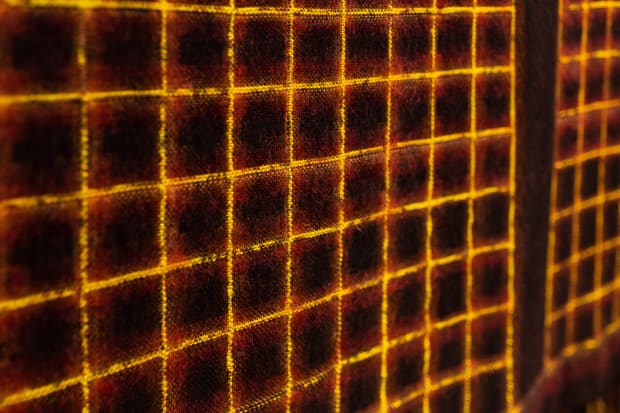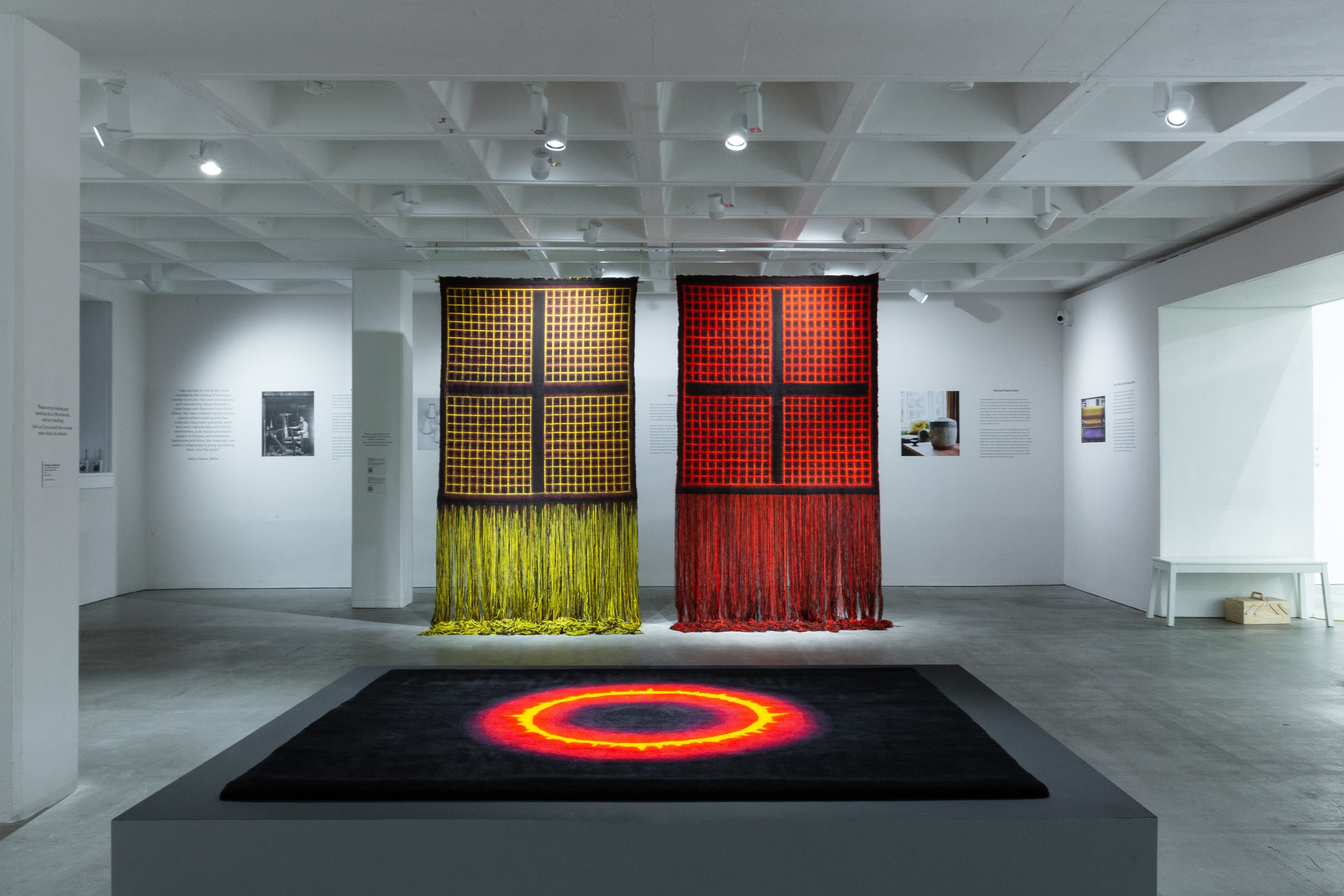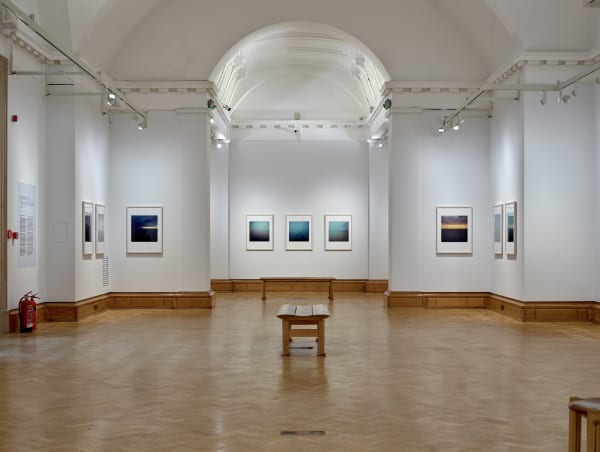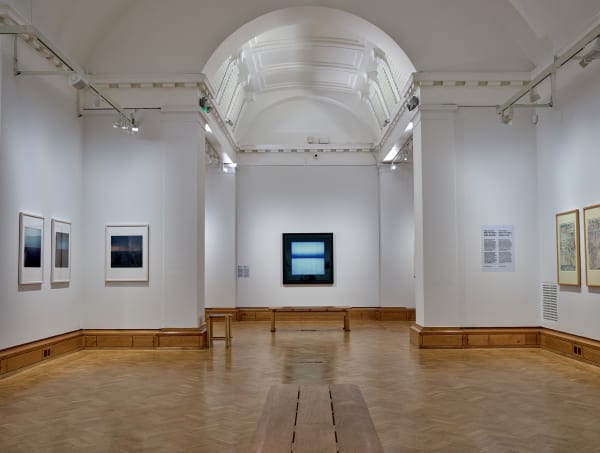-
-
Two museums have opened consecutive exhibitions celebrating the life and work of Garry Fabian Miller. ADORE at The Arnolfini Gallery in Bristol looks at the artist’s career over nearly fifty years. Môrwelion at the National Museum of Wales in Cardiff, presents one of his very first bodies of work in its entirety – Sections of England: The Sea Horizon, a sequence of 40 photographs made in 1976-77, exploring the meeting of sea and sky across the Severn Estuary, made at Clevedon, west of Bristol, looking towards the Welsh coast. A series of pictures which, with pleasing circularity, were first shown across the water at the Arnolfini, when Garry was only 19.
As he has said:"This body of work has found its way home in a way that I couldn’t have imagined. The first work I ever made is existing in the place that it was made about.”
It’s fitting then that ADORE at the Arnolfini also starts with a wall of these early camera-based explorations of place and rootedness and positions them between two later dark room based ‘abstract’ works in which a now imagined horizon continues as a constant.
-
-
 Garry Fabian MillerSections of England: The Sea Horizon No. 4, 1976-7Series 2, printed 2013
Garry Fabian MillerSections of England: The Sea Horizon No. 4, 1976-7Series 2, printed 2013
Lambda C-type print
Edition of 538.1 x 38.1 cm image size
63.5 x 63.5 cm frame size -
 Garry Fabian MillerSections of England: The Sea Horizon - No 16, 1976-7Series 2, printed 2013
Garry Fabian MillerSections of England: The Sea Horizon - No 16, 1976-7Series 2, printed 2013
Lamda C-type print
Edition of 538.1 x 38.1 cm print size
49.5 x 49.5 cm framed -
 Garry Fabian MillerSections of England: The Sea Horizon No.17, 1976-7Series 2, printed 2013
Garry Fabian MillerSections of England: The Sea Horizon No.17, 1976-7Series 2, printed 2013
Lambda C-type print
Edition of 538.1 x 38.1 cm image size
63.5 x 63.5 cm frame size -
 Garry Fabian MillerSections of England: The Sea Horizon No. 37, 1976-7Series 2, printed 2013
Garry Fabian MillerSections of England: The Sea Horizon No. 37, 1976-7Series 2, printed 2013
Lambda C-type print
Edition of 538.1 x 38.1 cm image size
63.5 x 63.5 cm frame size
-
-
 Garry Fabian MillerThe Return, 2014-15light, water, Lambda c-type print from unique dye destruction print
Garry Fabian MillerThe Return, 2014-15light, water, Lambda c-type print from unique dye destruction print
Edition 1 of 3 with 2 APs147.5 x 122 x 7.5 cm (framed)
58 1/8 x 48 1/8 x 3 in -
 Garry Fabian MillerVoyage Across The Golden Sea, 2013light, oil, Lambda c-type print from unique dye destruction print
Garry Fabian MillerVoyage Across The Golden Sea, 2013light, oil, Lambda c-type print from unique dye destruction print
Edition of 3 with 2 APs. This is AP1.120.5 x 142.5 cm
47 3/8 x 56 in (framed) -
In 1985 Miller made a radical step - giving up the camera altogether and putting the plant form itself directly in line with a source of light so that its form and colour was transferred onto a piece of light sensitive (Cibachrome) paper. And so began his experiments into camera-less photography, taking the first principles of photography as pioneered by the likes of William Henry Fox Talbot in the 1830s - the action of light on light-sensitive paper - to make works of growing and gathering complexity.
-
 Garry Fabian MillerFoxglove, 17th July 2011, 2011Flower, light, unique dye destruction print25.4 x 20.3 cm
Garry Fabian MillerFoxglove, 17th July 2011, 2011Flower, light, unique dye destruction print25.4 x 20.3 cm
10 x 8 in
(print size)
44.5 x 38.1 cm
17 1/2 x 15 in
(framed size) -
 Garry Fabian MillerWaiting, one hundred days, April 18th - July 25th, 2011leaf, light, 120 unique dye destruction prints11.4 x 8.9 cm
Garry Fabian MillerWaiting, one hundred days, April 18th - July 25th, 2011leaf, light, 120 unique dye destruction prints11.4 x 8.9 cm
4 1/2 x 3 1/2 in (each print)
211 x 211 cm
83 1/8 x 83 1/8 in (framed) -
Miller’s use of plant forms echoes the photographic pioneers of the nineteenth century, but also stems from his own deep engagement with place and in particular the land around his studio on Dartmoor and the home that he has shared with his family for 30 years, high on the moor where he walks every day in pursuit of the moments of light that sustain and guide his way of seeing the world. As he said in a recent interview in the Journal of the Royal Society of Photography – "Landscape, Home: These are the sites from which my pictures come. The primary focus of my life is my relationship with the sun - all my adult life has been based around its arrival and its end, and how I engage with it across the day."
-
 Garry Fabian MillerBramble Robin (iv) - Hayne Down, Spring, 2011leaf, light, dye destruction print23.2 x 16.4 cm print size
Garry Fabian MillerBramble Robin (iv) - Hayne Down, Spring, 2011leaf, light, dye destruction print23.2 x 16.4 cm print size
45.6 x 37.9 cm framed -
 Garry Fabian MillerAnne, Allium, Homeland, June, 2011Flower, light, seven unique dye destruction prints24.4 x 19.1 cm
Garry Fabian MillerAnne, Allium, Homeland, June, 2011Flower, light, seven unique dye destruction prints24.4 x 19.1 cm
9 5/8 x 7 1/2 in (each print)
45.3 x 194.3 cm
17 7/8 x 76 1/2 in (framed) -
At the Arnolfini, this engagement with the daily rhythm of the sun extends also to the moon and the night sky in a series of works that reflect Miller’s interest in darkness as well as light. This is the life of the darkroom – an interior thinking space as well as a place of picture making.“In Blake’s imagined room sits the poet, perhaps with eyes shut, thinking of an illuminated world. This is how I lived and worked in my darkroom”.
-
 Garry Fabian MillerSites of Departure: The Book, 2019light, water, Lambda c-type print from unique dye destruction print
Garry Fabian MillerSites of Departure: The Book, 2019light, water, Lambda c-type print from unique dye destruction print
Edition 3 of 3 with 2 APs73.4 x 84.6 cm
28 7/8 x 33 1/4 in (print)
92.4 x 103.6 x 7.5 cm
36 3/8 x 40 3/4 x 3 in (framed) -
 Garry Fabian MillerThe Night Drift, 2009 - 2018Light, water, lambda C-print from unique dye destruction print
Garry Fabian MillerThe Night Drift, 2009 - 2018Light, water, lambda C-print from unique dye destruction print
Edition 1 of 3 with 2 APs142.2 x 167.7 x 7.7 cm
56 x 66 1/8 x 3 1/8 in
(framed) -
The science of this is quite simple. Miller uses 'positive' photographic paper that has been coated in layers of dyes (red, blue, green - the three primaries from which all other colours can be made) and by manipulating a beam of light on its way from source to the surface of the paper (sending it through coloured liquids to pick up 'pure' colour and then through objects and constructions to make shapes that allow light through, or block sections to keep it out). The works made in the darkroom in this way are unique, one of a kind, prints - each new experiment effectively a leap of faith guided by the knowledge of past, but with the results unseen until being developed. In this way he often works in series, making small changes from one day to the next, often with enormously long exposures.
-
-
 Garry Fabian MillerThe Golden Flood, 2014-15light, oil, Lambda c-type print from unique dye destruction print
Garry Fabian MillerThe Golden Flood, 2014-15light, oil, Lambda c-type print from unique dye destruction print
Edition of 3 with 2 APs. This edition AP1.135.5 x 158.5 cm
53 3/8 x 62 3/8 in (framed) -
 Garry Fabian MillerThe Maggot, 2015light, oil, Lambda c-type print from unique dye destruction print
Garry Fabian MillerThe Maggot, 2015light, oil, Lambda c-type print from unique dye destruction print
Edition 2 of 3 with 2 APs135.5 x 145 cm
53 3/8 x 57 1/8 in (framed) -
 Garry Fabian MillerThe Darkroom's Fading Presence, 2020Light, oil, Lambda c-type print from dye destruction print
Garry Fabian MillerThe Darkroom's Fading Presence, 2020Light, oil, Lambda c-type print from dye destruction print
Edition of 3 with 2 APs, this is AP1.130.5 x 135.5 cm
51 3/8 x 53 3/8 in (framed)
-
-
Over the last decade, in parallel to the extinction of his precious Cibachrome paper, he has embraced a new way of working in collaboration with the colour scanning specialist John Bodkin, a decade, as Garry describes it, “spent exploring and connecting the worlds of chemical and digital colour space”. Bodkin’s understanding of new technologies, and in particular the Lambda c-print process has introduced the possibility of a new kind of camera-less image made on a larger scale, capturing the last Cibachrome experiments in a new paper that turns out to have the same qualities (particularly in the ability to hold a balance between solid and fluid colour) as the originating Cibachrome print.
-
 Garry Fabian MillerWithin the Green Hill, 2022oil, light, Lambda c-type print from unique dye destruction print
Garry Fabian MillerWithin the Green Hill, 2022oil, light, Lambda c-type print from unique dye destruction print
edition 1 of 3135.5 x 135.5 cm
53 3/8 x 53 3/8 in (framed)edition of 3 plus 2 artist proofs -
The idea of these new works, and indeed of Garry Fabian Miller as an artist, as a bridge between old technologies (old learning if you like) and new possibilities, is an important thing to grasp. He continues to pursue new methods of making in a truly pioneering way, even whilst the materials on which he depends come to an end. The support of various important institutions, including the V&A in London (home of the National Photography Collection) and the Bodleian Library at Oxford University, at this moment in which he continues to find ways to work meaningfully beyond the lifetime of his medium, brings us to a place of new possibilities. It has also brought him a new realm of collaboration with weavers and makers in translating his photographic experiments into a new medium.
-
 (detail) Garry Fabian Miller, Riuros (ii), 2022Shetland Wool, Italian Mohair, Merino Lambs Wool and Fluorescent Polyester Filaments.54 x 90 inches, Edition of 3 + 1AP, Edition 1/3
(detail) Garry Fabian Miller, Riuros (ii), 2022Shetland Wool, Italian Mohair, Merino Lambs Wool and Fluorescent Polyester Filaments.54 x 90 inches, Edition of 3 + 1AP, Edition 1/3 -
 (from left to right) Garry Fabian Miller, Riuros (ii), Riuros (iii), (both) 2022, Shetland Wool, Italian Mohair, Merino Lambs Wool and Fluorescent Polyester Filaments, 54 x 90 inches. Edition of 3 + 1AP. Edition 1/3. Photograph: Lisa Whiting
(from left to right) Garry Fabian Miller, Riuros (ii), Riuros (iii), (both) 2022, Shetland Wool, Italian Mohair, Merino Lambs Wool and Fluorescent Polyester Filaments, 54 x 90 inches. Edition of 3 + 1AP. Edition 1/3. Photograph: Lisa Whiting -
Ethel Mairet’s 1916 A Book on Vegetable Dyes, has led Garry to think backwards into new kind of colour production which promises to take his work back to the context of land art in which he first started, but this time with a project that involves planting Three Acres of Colour – a proposal to grow the primary colours in the English landscape. Amongst the final works made on Cibachrome in the dark room are those that he has collectively titled The Ark – an exploration of the three primary colours through exposures of vastly differing lengths – a repository of colour knowledge to take forward into the future.
-
 Garry Fabian MillerThe Ark, 2020light, water, oil, twenty-seven unique dye destruction prints43.3 x 33.2 x 4.5 cm
Garry Fabian MillerThe Ark, 2020light, water, oil, twenty-seven unique dye destruction prints43.3 x 33.2 x 4.5 cm
17 x 13 1/8 x 1 3/4 in (each print, framed) -
 Garry Fabian MillerColoured Seed 2, 2020light, water, Lambda c-type print from unique dye destruction print
Garry Fabian MillerColoured Seed 2, 2020light, water, Lambda c-type print from unique dye destruction print
edition 1 of 3126.9 x 96.4 x 6.7 cm
50 x 38 x 2 5/8 in (framed)edition of 3 plus 2 artist proofs -
-
 Garry Fabian MillerThe Colour Field: a purple blue holds the floating pale yellow, 2021Light, water, oil, Lambda c-type print from unique dye destruction print
Garry Fabian MillerThe Colour Field: a purple blue holds the floating pale yellow, 2021Light, water, oil, Lambda c-type print from unique dye destruction print
edition 1 of 3 with 2 APs111 x 111 cm (framed)
43 3/4 x 43 3/4 in -
 Garry Fabian MillerThe Colour Field: Red Embraces Blue, 2021light, water, Lambda c-type print from unique dye destruction print
Garry Fabian MillerThe Colour Field: Red Embraces Blue, 2021light, water, Lambda c-type print from unique dye destruction print
artist proof 2 of 2111 x 111 cm (framed)
43 3/4 x 43 3/4 inedition of 3 plus 2 artist proofs -
 Garry Fabian MillerThe Colour Field: gold embraces the softest pink, 2021Light, water, Lambda c-type print from unique dye destruction print
Garry Fabian MillerThe Colour Field: gold embraces the softest pink, 2021Light, water, Lambda c-type print from unique dye destruction print
artist proof 1 of 2111 x 111 cm (framed)
43 3/4 x 43 3/4 inedition of 3 plus 2 artist proofs
-
-
The next chapter belongs to a story which will continue to unfold, but at its heart is what Garry’s describes as his ‘deep kinship’ with Mairet’s view, that “strong and beautiful colour is an essential to the full joy of life”. It is a code by which he has lived his own life, and which is perfectly expressed by the Colour Field works which have brought his work as an abstract photographer to a close.
-
 Garry Fabian MillerThe Colour Fields: the golden land holds the blue and red, 2021Light, water, Lambda c-type print from unique dye destruction print
Garry Fabian MillerThe Colour Fields: the golden land holds the blue and red, 2021Light, water, Lambda c-type print from unique dye destruction print
edition 1 of 3 with 2 APs146.7 x 221.6 x 7.6 cm
57 3/4 x 87 1/4 x 3 in (framed) -
 Garry Fabian MillerThe Colour Field: the black ground, 2021Light, water, oil, pigment print from unique dye destruction print on cotton rag paper
Garry Fabian MillerThe Colour Field: the black ground, 2021Light, water, oil, pigment print from unique dye destruction print on cotton rag paper
edition 1 of 3 with 2 APs124.5 x 124.5 cm
49 x 49 in (framed) -
 Garry Fabian Miller at the opening of ADORE, Arnolfini, 2023. Photograph: Lisa Whiting
Garry Fabian Miller at the opening of ADORE, Arnolfini, 2023. Photograph: Lisa Whiting
Garry Fabian Miller | ADORE
Current viewing_room

